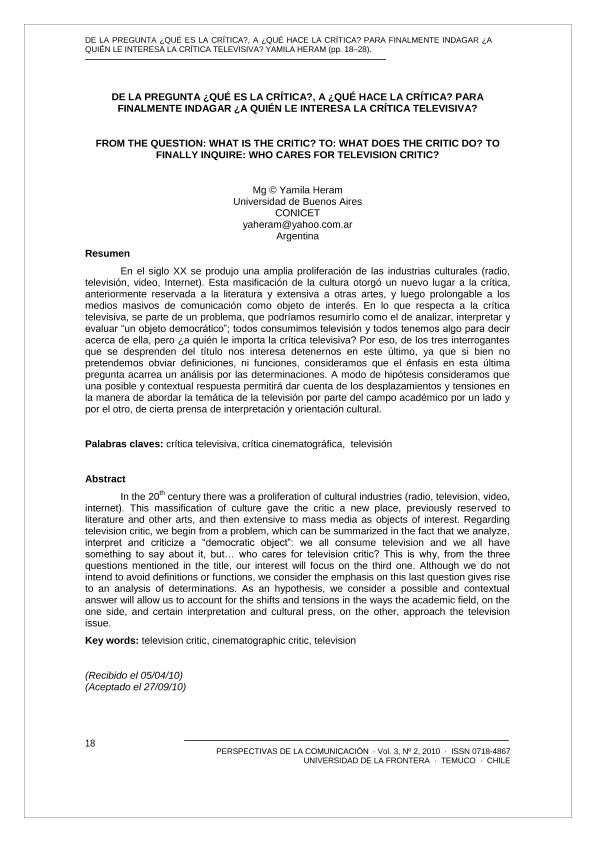Mostrar el registro sencillo del ítem
dc.contributor.author
Heram, Yamila

dc.date.available
2023-03-15T14:32:27Z
dc.date.issued
2010-10
dc.identifier.citation
Heram, Yamila; De la pregunta, ¿Qué es la crítica? a ¿Qué hace la crítica? para finalmente indagar ¿A quién le importa la crítica televisiva?; Universidad de La Frontera; Perspectivas de la Comunicación; 3; 2; 10-2010; 18-28
dc.identifier.issn
0718-4867
dc.identifier.uri
http://hdl.handle.net/11336/190602
dc.description.abstract
En el siglo XX se produjo una amplia proliferación de las industrias culturales (radio, televisión, video, Internet). Esta masificación de la cultura otorgó un nuevo lugar a la crítica, anteriormente reservada a la literatura y extensiva a otras artes, y luego prolongable a los medios masivos de comunicación como objeto de interés. En lo que respecta a la crítica televisiva, se parte de un problema, que podríamos resumirlo como el de analizar, interpretar y evaluar “un objeto democrático”; todos consumimos televisión y todos tenemos algo para decir acerca de ella, pero ¿a quién le importa la crítica televisiva? Por eso, de los tres interrogantes que se desprenden del título nos interesa detenernos en este último, ya que si bien no pretendemos obviar definiciones, ni funciones, consideramos que el énfasis en esta última pregunta acarrea un análisis por las determinaciones. A modo de hipótesis consideramos que una posible y contextual respuesta permitirá dar cuenta de los desplazamientos y tensiones en la manera de abordar la temática de la televisión por parte del campo académico por un lado y por el otro, de cierta prensa de interpretación y orientación cultural.
dc.description.abstract
In the 20th century there was a proliferation of cultural industries (radio, television, video, internet). This massification of culture gave the critic a new place, previously reserved to literature and other arts, and then extensive to mass media as objects of interest. Regarding television critic, we begin from a problem, which can be summarized in the fact that we analyze, interpret and criticize a "democratic object": we all consume television and we all have something to say about it, but... who cares for television critic? This is why, from the three questions mentioned in the title, our interest will focus on the third one. Although we do not intend to avoid definitions or functions, we consider the emphasis on this last question gives rise to an analysis of determinations. As an hypothesis, we consider a possible and contextual answer will allow us to account for the shifts and tensions in the ways the academic field, on the one side, and certain interpretation and cultural press, on the other, approach the television issue.
dc.format
application/pdf
dc.language.iso
spa
dc.publisher
Universidad de La Frontera
dc.rights
info:eu-repo/semantics/openAccess
dc.rights.uri
https://creativecommons.org/licenses/by/2.5/ar/
dc.subject
CRÍTICA
dc.subject
TELEVISIÓN
dc.subject
CINE
dc.subject.classification
Comunicación de Medios y Socio-cultural

dc.subject.classification
Comunicación y Medios

dc.subject.classification
CIENCIAS SOCIALES

dc.title
De la pregunta, ¿Qué es la crítica? a ¿Qué hace la crítica? para finalmente indagar ¿A quién le importa la crítica televisiva?
dc.title
From the question: What is the critic? to: What does the critic do? To finally inquire: Who cares for television critic?
dc.type
info:eu-repo/semantics/article
dc.type
info:ar-repo/semantics/artículo
dc.type
info:eu-repo/semantics/publishedVersion
dc.date.updated
2023-03-15T10:07:11Z
dc.journal.volume
3
dc.journal.number
2
dc.journal.pagination
18-28
dc.journal.pais
Chile

dc.journal.ciudad
Temuco
dc.description.fil
Fil: Heram, Yamila. Consejo Nacional de Investigaciones Científicas y Técnicas; Argentina. Universidad de Buenos Aires. Facultad de Ciencias Sociales. Instituto de Investigaciones "Gino Germani"; Argentina
dc.journal.title
Perspectivas de la Comunicación
dc.relation.alternativeid
info:eu-repo/semantics/altIdentifier/url/https://www.perspectivasdelacomunicacion.cl/ojs/index.php/perspectivas/article/view/93
Archivos asociados
